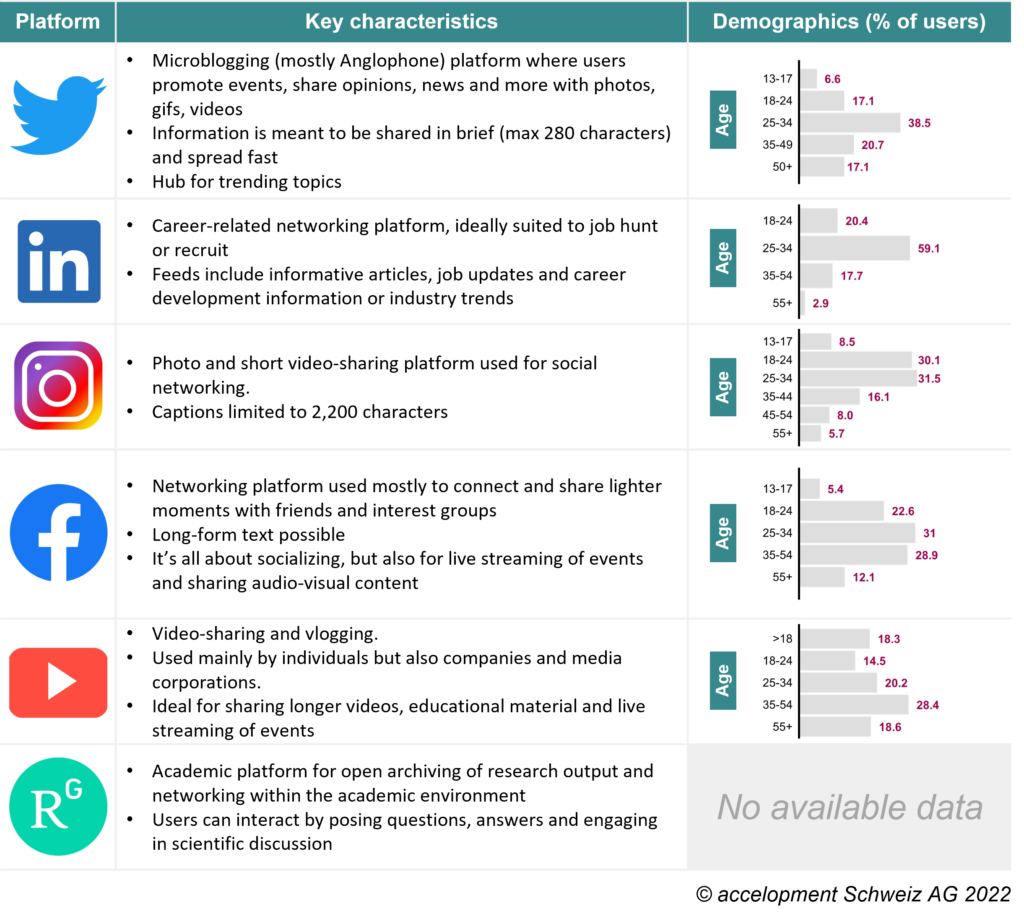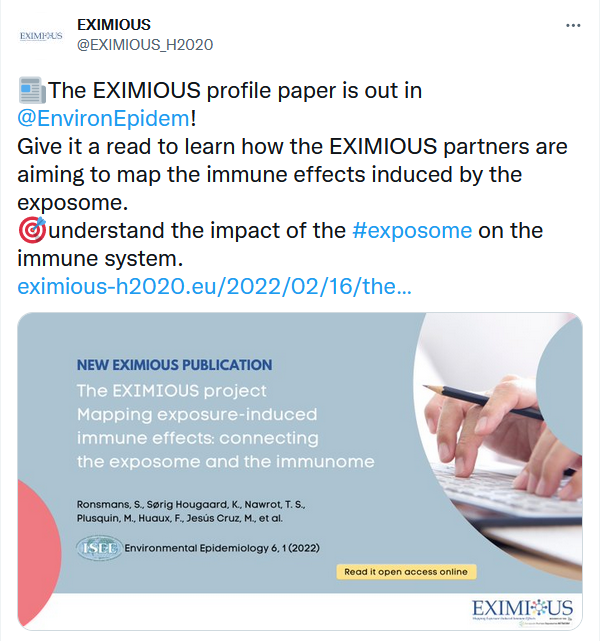Social media for EU projects – where to start?
12th July 2022 at 3:32 pm
Communication is at the heart of our society and it is also a key requirement and contractual obligation for all EU-funded projects, alongside the dissemination and exploitation of results. Through well-planned and regular communication activities, we can give EU-funded projects the visibility needed to reach a wide range of stakeholders, inform about the project’s relevance to society, its latest results, the benefits of research progress, as well as build new collaboration opportunities and open market avenues. While having a dedicated project website is a well-established requirement, over the last years the use of social media for EU project communication has been increasingly encouraged by the EC. In this first blog post of a series, we share some advice and tips on where to start.
Already in 2011, Kietzmann et al. referred to the social media environment as a jungle. As of January 2022, following a constant increase in social media usage and the appearance of new platforms, 58.4% of the global population made use of social media and spent on average 2.5 hours on social media each day. The amount of content generated, shared and made available through these platforms is enormous. The jungle is growing, and while it’s easy to get there, it can take substantial effort, knowledge and resources for EU projects to make their way through it. So, while we wait for the EC to release their guidelines for Horizon Europe social media use, here come our communications team’s suggestions to make it an effective and enjoyable journey through the jungle.
Define a strategy
Similarly to the approach we recommended for developing a Plan for Dissemination and Exploitation including Communication activities (PDEC), the very first step with social media is to take the time to plan and prepare, by defining a strategy. The project’s social media strategy can and should build upon the overall project’s communication strategy developed in the PDEC. The situation analysis and stakeholder analysis developed in that context can help define the social media objectives, key messages and activities, which should be aligned with those defined in the PDEC. Of key importance is to identify roles and responsibilities, which goes partly hand-in-hand with deciding which social media platforms to use. Since an essential aspect of social media is to share content regularly, within EU projects the input and support from all partners will be of great value, and can be leveraged at best when using platforms that they are familiar with, as we will get back to in the next section. In MSCA-ITNs/DNs, we recommend for the ESRs/DCs to take on an active role in managing the social media channels, after being made aware of all specific EU requirements for communication and dissemination. In health projects that involve patient organisations, having their contribution in creating and sharing content can be very effective, especially when building on their wide-reaching, established networks and their understanding of patients’ needs. In innovation actions that include several research organisations and industry partners, collaborating with their public relations or communications departments for the definition of content and further sharing of posts can be a game changer in the effectiveness of the project’s social media use.
Once all the above has been considered, it’s good to plan some first activities and a general strategy to be used to communicate about topics that are common and expected in EU projects, e.g., partner profiles and their contributions to the project, open positions, new team members, participation at events, new publications, public deliverables. There will, naturally, be many other opportunities for social media activities throughout the course of the project, which will require ad hoc preparation, but having a defined yet flexible strategy in place for those that are expected and somewhat standard, will save some time later and help ensure all is in place for timely communication. This is also good content to use to start building a community around a new social media account and after a first test period assess whether the material developed and the chosen channel is reaching the desired audience, or if it would make most sense to focus on other channels instead.
Last but not least, setting Key Performance Indicators with specific targets for each social media objective and regularly monitoring the progress made towards achieving these, will be essential in adapting the activities, efforts and resources for the best use of the chosen platforms while also keeping on track with the continuous reporting on outreach activities towards the EC. This, again, should be considered in line with the PDEC. Conveniently, most if not all social media platforms come with built-in analytics, which can be exported directly from each platform or overseen and assessed through social media management platforms, such as Hootsuite, Buffer and others.
Choose the right platform for the right audience and needs
Today, there are more than 17 different social media platforms that count more than 300 million monthly active users, the leading one being Facebook (>2.9 billion users), followed by YouTube (>2.5 billion users) and Instagram (~1.5 billion users). Each has a slightly different focus and the demographic of their users also varies. When communicating about EU-funded projects, it’s key to keep in mind the stakeholders to be reached as well as the user preferences of the project partners. The aim of reaching the key stakeholders goes without explaining, while keeping the partners’ social media preferences in mind will help in reaching a larger impact when sharing social media content. Before even thinking of growing a large network of followers, the project partners are the stakeholders with supposedly the most interest in communicating about the project, thus using platforms that they already engage with means it will be easier for them to share the communication further. Conveniently, that in turn already feeds into more easily growing a network through the partners’ established connections.
Throughout our experience with more than 79 funded EU projects, the most commonly used social media tools among partners and then also for the projects’ communication are Twitter, LinkedIn, ResearchGate, Facebook, YouTube and Instagram (mostly within MSCA-ITNs). The user demographics also suggest that a combined use of different platforms covers the most common stakeholders encountered across different projects. While clearly LinkedIn is the platform designed for professionals and ResearchGate for researchers, Facebook seems to be the most used among the older age groups and Instagram is most skewed towards the younger generations. Alongside considering the users, not all platforms are well suited for all types of content or all stages of a project. For example, in the case of a health project that is recruiting patients aged 60+ for a clinical trial, the use of Facebook could allow to better reach them, whereas when wanting to share new educational and training material for high-school students, platforms like Instagram or YouTube (or even Tik Tok) might result in a better audience reach.

A combined and interlinked use of multiple platforms for different purposes and occasions will make for the most effective sharing of different communication material, e.g., written, visual, audio-visual. At the same time, since each platform will require content contribution, we recommend considering when the most appropriate time is to launch the use of each platform. Having an inactive account for several months can look unprofessional, especially on platforms that are known for their fast-paced content sharing.
Connect, engage and exchange
Once the project accounts are launched on the chosen platform(s), it’s time to connect and build a community. While traditional media involves a one-way exchange, social media has its name for a reason, and it enables a more engaging two-way exchange. Building a network from the partners and key stakeholders of the project will be a good start. Connecting with other EU-funded projects working on similar topics, key companies, associations, events, conferences and journals in the project’s focus area will help keeping up to date on the latest developments and contribute to these. To aid with this, the EC has put together an overview of key channels and hashtags of relevance to EU projects.
And then? The big question is how to maintain and grow the project’s connections to have a broader reach. Engaging and exchanging are at the heart of social media. For this, making use of hashtags and tagging relevant channels is the ABC of most social media platforms, as it allows other users to find content more easily, stay connected on a specific topic and help achieve a wider reach. Asking questions in posts and commenting on those of others, when relevant, helps gather an understanding of stakeholders’ needs, while also opening opportunities for further conversations, increases visibility and often results in new connections. Platforms like Facebook, LinkedIn, Twitter and Instagram also have a built-in messaging function, which should not be forgotten. Reaching out to other channels asking to re-share a specific post or help support a campaign can be rather useful. Likewise, if there is relevant content out there from other channels then it’s good practice to share it further, without overdoing it. And content is indeed key, which is why we invite you to keep an eye out for our next social media blog post, where the focus will be on sharing tips and examples on how to create engaging content for EU-funded projects.
With a passion for learning and continuous development, our communications team also values the importance of knowledge sharing and building on previous experiences, which is why in the coming months they will publish a series of blog posts offering guidance and tips to implement in the communication, dissemination, and exploitation of your own research or innovation. As partners leading the communication, dissemination and exploitation activities of more than 30 Horizon 2020 projects, and now in already eleven Horizon Europe projects, our team has a wealth of knowledge and experiences to share, so stay tuned and reach out for more information.

Julia Götz
COO

Joanna Plesniak
Project Manager Communications
References:
Auxier, B., & Anderson, M. (2021, April 7). Social Media Use in 2021. Pew Research Center: Internet, Science & Tech. https://www.pewresearch.org/internet/2021/04/07/social-media-use-in-2021/
Statista. (2022a, March 8). Facebook: distribution of global audiences 2022, by age and gender. https://www.statista.com/statistics/376128/facebook-global-user-age-distribution/
Statista. (2022b, March 14). LinkedIn: distribution of global audiences 2022, by age group. https://www.statista.com/statistics/273505/global-linkedin-age-group/
Statista. (2022c, March 29). Twitter: distribution of global audiences 2021, by age group. https://www.statista.com/statistics/283119/age-distribution-of-global-twitter-users/
Statista. (2022d, May 12). Instagram: distribution of global audiences 2022, by age group. https://www.statista.com/statistics/325587/instagram-global-age-group/
Statista. (2022e, May 13). YouTube: distribution of global audiences 2022, by age and gender. https://www.statista.com/statistics/1287137/youtube-global-users-age-gender-distribution/


